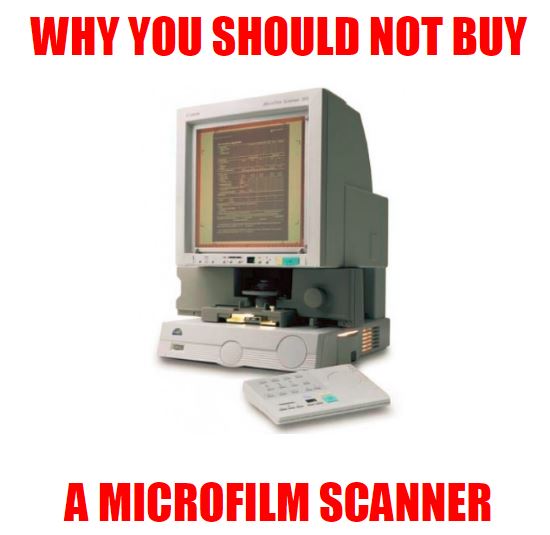Do you have to convert microform and thinking of buying a microfilm scanner?
A microfilm scanner is a specialized type of scanner that handles microform media. It converts information on microfilm and microfiche to digital image formats that you can read on your computer.
We think that buying a microfilm scanner is only worth it when outsourcing is either too expensive or is not possible logistically.
The reasons mentioned below will give you all the information to reach the right conclusion and clearly determine whether you should buy a machine or just go for services.
Reason 1: Microfilm scanner price
The cost of a microfilm scanner should be the first thing that pops to your mind when thinking of buying one.
The first thing to watch for is pretty straightforward. Do a price compare and find the cheapest equipment that will solve your issue. If the price is still high for you, maybe you should just focus on services.
At least shop around and check if the cost of scanning services is ok for you. If the price of the equipment seems ok for you, now it’s time to check what other costs you will have.
Do you need operators? Do you have to get extra software or hardware for the job? Do you actually have enough time to do it?
These are also cost factors, so always check them before buying a machine. If it still seems pretty straightforward, then you should go and buy a microfilm scanner. Otherwise, stay away and don’t do it.
Reason 2: Microfilm scanner comparison
Once you have decided you do have to buy a microfilm scanner, go ahead and check your options. Think clearly about what you need from the scanning equipment.
You might need one that converts both 16mm and 35mm microfilm.
In this case, you have to limit yourself to equipment that is capable of handling both types.
Do you also have microfiche?
Well, if that’s the case, you will be limited to even fewer machines or options. Talk to microfilm scanner providers and tell them what you expect from the machine. They can test most of your requests, so insist on this aspect.
Once the scanner has passed the test, only then you can consider it as an option. If it fails the test, ask more.
See what was the reason for the failure. Is there something that can be done differently? Can they upgrade the machine so it passes the test? These aspects have to be considered.
Reason 3: How much scanning from microfilm do you have to do
The microfilm volume is one of the main aspects you should worry about. You should not get a machine intended for larger volumes if you only have to convert a couple of microfilms.
On the other hand, an entry-level microfilm scanner should not be your choice if you have larger volumes. Take into consideration the actual productivity you need from the scanning equipment.
Scanners intended for industrial conversion will have high scanning speed and be able to maintain it in the post-processing phase.
Entry level microfilm scanners usually are intended for light usage. That is why they have less powerful components and lower data transfer speeds.
Remember, besides scanning, you will be transferring a lot of data. You need the fastest USB, but we always recommend a LAN connection.
Reason 4: Do you have enough experience and workforce
Especially in large microfilm scanning projects, experience and workforce can save a lot of costs. If you don’t have them though, it might end up costing you way more.
Be careful in drawing out a plan for your scanning project. Find the right people for the job, and make sure they can stick to it. Microfilm scanning specialists are hard to find these days.
Yes, you might be able to teach a person to do the scanning, but it will take a while. In case of large projects, time is money, so you can’t risk investing your time only in educating operators.
If you can evaluate all the costs before, just try and see how much it would cost you to outsource the project. Compare to your costs and analyze if the price is worth it to opt for scanning services.
Reason 5: You have better things to do and just need the documents from microfilm
This last reason is very interesting. In most cases, you have to understand why you need the documents from microfilm.
If you are planning on using the actual information on those documents, then the end game is different.
Is it actually worth investing your time in the conversion, or is it better to invest it in analyzing the information on those microfilms. For example, our insurance and banking customers, usually need the information to analyze it.
They don’t want to invest in the hassle of getting machines, personnel and all the rest. What they want is for the information to be delivered to their analysts in PDF formats.
This way, they optimize the analysis process and make sure everything is streamlined. Their job is not to convert microfilm to digital formats. They have to sell their own products and services to their customers.
They don’t see scanning microfilm as something they want to do, rather they need the results of this process.
What should my decision be
Given all the reasons and factors above, you should be able to know if you should buy a scanning machine or just go for services.
If you only want the information and none of the conversion hassle, then buying a microfilm scanner does not make sense.
When the volume of microfilms is not very large, the same conclusion can apply. Same goes when you don’t have experience or the right human resources.
With all this, we consider that you should not buy a microfilm scanner unless the services are too expensive, logistically it would be impossible, or you are actually doing a microfilm scanning business.






